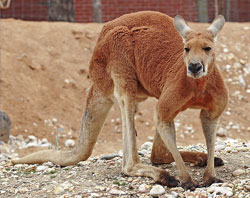 A Kangaroo is a marsupial mammal. It is a macropod which means "big foot". They have soft fur, large powerful hind legs and long thick tail.
A Kangaroo is a marsupial mammal. It is a macropod which means "big foot". They have soft fur, large powerful hind legs and long thick tail.- Kangaroos are pure herbivores, feeding on grasses, shrubs, and sometimes even fungi.
- A long-standing myth says that the kangaroo’s name actually derives from a miscommunication between Cook and the aboriginal peoples. When Cook asked the locals the name of the species, they responded with the word “kangaroo”—supposedly translating to “I don’t know.” This, however, was not the case.
- As a kangaroo jumps, it expels out air from its lungs and brings its feet forward ready for refilling its lungs as soon as it lands.
- The Kangaroo moves by hopping on its powerful hind legs. It uses its thick long tail to balance its body while hopping. A kangaroo can hop at up to 60kmh (40mph). It can also leap over obstacles up to 3m (10ft) high.
- Because of the unusual shape of its legs and its bulky tail a kangaroo can't walk or move backwards very easily.
- A male kangaroo is called a buck, boomer, or jack and a female is referred to as a doe, flyer, or jill.
- If you lift a kangaroo's tail off the ground, it can't hop. Roos use their tail for balance.
-
<script type="text/javascript">// <![CDATA[
Male kangaroos do not have pouches.
google_ad_client = "pub-2970895246189115";
/* 336x280, created 12/3/10 */
google_ad_slot = "6039910414";
google_ad_width = 336;
google_ad_height = 280;
// ]]></script>
<script src="http://pagead2.googlesyndication.com/pagead/show_ads.js" type="text/javascript">
</script> - There are 47 varieties of kangaroo, ranging in size from the two-pound rock wallaby to the 6-foot, 300-pound red kangaroo.
- Kangaroos live up to 20 years in captivity, but only six in the wild.
- Kangaroos are found in Australia, Tasmania, and New Guinea. Most are terrestrial and all are herbivorous, grazing and browsing for their food.
- Each long, narrow hind foot has four toes. The short forelimbs are used almost like human arms, but the thumb is not opposable.
- Kangaroos possess soft, wooly fur, and some have stripes on the head, back, or upper limbs.
- All kangaroos have a chambered stomach that is functionally similar to those of such ruminants as cattle and sheep. They regurgitate the vegetation they have eaten, chew it as cud, and then swallow it again for final digestion.
- Kangaroos need very little water to survive and are capable of going for months without drinking at all. When they do need water, they dig "wells" for themselves, frequently going as deep as three or four feet.
- Red Kangaroos are able to survive temperatures in excess of 40C by using shade and avoiding activity during the day. They can also concentrate their urine to conserve water and thus can tolerate severe dehydration. They regulate their body temperature largely by panting and licking their forearms.
- Kangaroos are good swimmers.
- Kangaroos travel in groups (mobs) under the leadership of the largest male ("old man," or "boomer"), which dominates younger rivals by biting, kicking, and boxing.
- Kangaroos thump the ground with their feet to warn other members of the group of impending danger, such as a dingo attack.
- Kangaroos usually have one young annually. The young kangaroo, or joey, is born alive at a very immature stage, when it is only about 2 cm long and weighs less than a gram. Immediately after birth it crawls up the mother's body and enters the pouch. The baby attaches its mouth to one of four teats, which then enlarges to hold the young animal in place. After several weeks, the joey becomes more active and gradually spends more and more time outside the pouch, which it leaves completely between 7 and 10 months of age. Female kangaroos enter into heat within a few days after giving birth; they mate and conceive, but after only one week's development the microscopic embryo enters a dormant state that lasts until the previous young leaves the pouch. The development of the second embryo then resumes and proceeds to birth after a gestation period of about 30 days.
- Young kangaroo do pee and poop in the pouch. When they're small they don't produce much, and when they're bigger the pouch's lining absorbs some of it. As you can imagine, it gets kind of smelly in there, so moms clean out their pouches every now and then.
- Australian airline Qantas uses a kangaroo as their symbol.
- A Kangaroo is pictured on the Australian coat of arms.
- A Kangaroo is on the Australian dollar coin.
Sources:
http://en.wikipedia.org/wiki/Kangaroo
http://www.giftlog.com/pictures/kangaroo_facts.htm
http://nature.ca/notebooks/english/kanga.htm
http://australian-animals.net/red.htm
